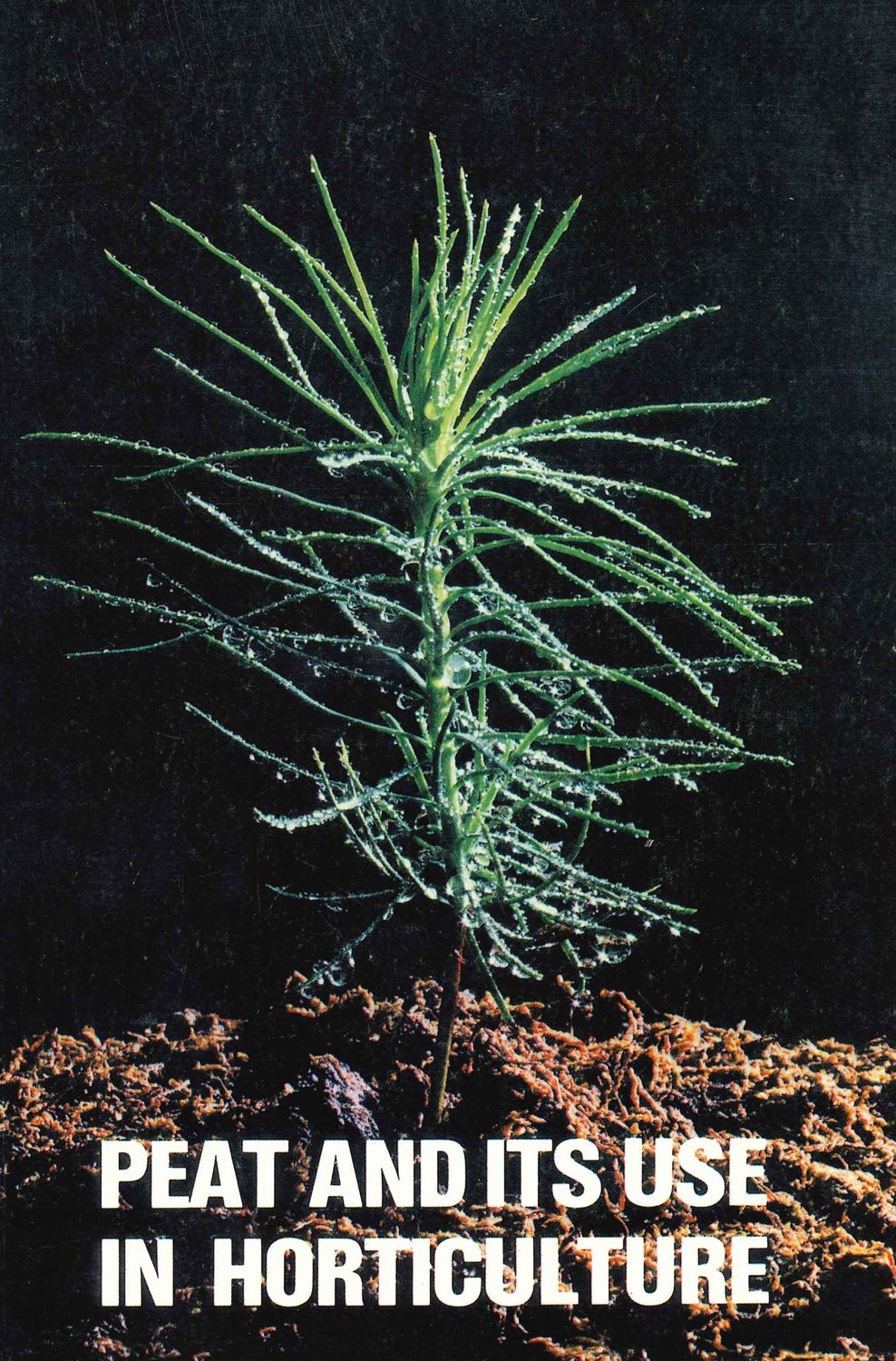Peat and its Use in Horticulture 1973/2004
Viljo Puustjärvi
Jyväskylä 2004 (reprint)
The original book in Finnish was published in 1973. The translation of the book was made possible by a grant from the Society of Finnish Literature. Published by the Association of Finnish Peat Industries.
ISBN 951-95397-0-0
160 pages
CONTENTS
PEAT AND ITS USE
The importance of humus for plant growth
The carbon cycle
Peat sources of the world
Bog type
Peat forming plants
Peat moss
True mosses
Sedges
Woody plants
Decomposition of peat
Chemical decomposition
Mechanical friction (breaking down)
Humic acids
Effect of frost on peat
Humates
Degree of decomposition
von Post scale
r-value
Volume weight as a measure of degree of decomposition
Classification
Slightly decomposed peat
Light sphagnum peat
Dark sphagnum peat
Sedge-moss peat
Sedge peat
Bryales peat
Forest peat (woody peat)
Strongly decomposed peat
Peat humus
Amorphous peat
Granular peat
Production methods
Sod peat method
Milled peat method
Peat products
Structure
Structural units
Formation of the structure
Stability of structure
Porosity
Measuring the structure
Product declaration
Peat standards
Sampling
Peat properties described in the product declaration
Certificate of guarantee
WATER
Water economy of plants
Mechanism of water uptake
Transpiration
Root activity
Renewal of roots
The need of air for roots
Effect of the reason on air volume requirements of the roots
Heat requirements of the roots
The water economy of peat
Retention of water in peat
Retention force
Effect of structure on the water economy of peat
Available water
Wilting point and field capacity in relation to available water
Available water in peat culture
Watering
Water requirements
Radiant energy as an indicator of water requirements
Evaporation from the surface of the peat
Relative humidity of air
Osmotic pressure of cell sap
Watering techniques
Moistening of dry peat
Frequency of watering
FERTILIZATION
Nutrients
Major nutrients
Nitrogen
Potassium
Calcium
Phosphorus
Sulphur
Magnesium
Trace elements
Iron
Manganese
Zinc
Boron
Copper
Molybdenum
Peat and nutrient storage
Acid property of peat
Fulvic acids
Humic acids
Humin
Peat acids as growth regulators
Cation exchange
The mechanism of cation exchange
Exchange capacity
The retaining force
Availability of exchangeable ions
The significance of exchangeable cations in the nutrient economy of plants
Chelated compounds
Feeding of plants
The mechanism of nutrient uptake
Growth factors
Nutrient levels
Optimum nutrient contents of plants
Activities of water-soluble and peat-retained nutrients
Effects of fertilisation levels on the nutrient content of the plant
Effects of fertilisation levels on the water economy of the plant
Effects of fertilisation levels on crop yields
Effects of light on the nutrient requirements of plants
Radiant energy as a major growth factor
The relationship between radiant energy and the water space of peat
Effect of the amount of light on the nutrient relationships
Liming
Plants and the acidity of the growing medium
Strength of root acids
Indirect effects of the pH
Lime requirements of peat
Liming materials
The use of potash as a top dressing
The use of liquid ammonium nitrate-ammonia solution as a top dressing
Quality requirements of lime
Ground limestone
Dolomitic limestone
The liming operation
Fertilisation
Main principles of fertilisation
Fertilisation requirements
Factors affecting fertilisation requirements
Leaching of nutrients
The fixation and release of nitrogen
Amounts of nutrients taken up by the plant
Total fertilisation requirements
Soil analysis for the assessment of fertilisation requirements
Methods of analysis
Sampling
Electrical conductivity
Unit of conductivity
Conductivity as an indicator of the water economy of the plants
Conductivity as an indicator of the nutrient economy of peat
Plant analysis as an indicator of fertilisation requirements
Fertilisation levels
Reasons for different fertilisation levels
Plant grouping according to the optimum fertilisation level
Fertilisation level I
Forced bulbs
Cuttings
Seeds
Epiphytes
Slowly growing plants
Young plants
Fertilisation level II
Fertilisation level III
Nutrient contents at different levels of fertilisation
Nitrogen and potassium
Calcium and magnesium
Phosphorus
Sulphur
Effects of growing techniques on the fertilisation level
Base dressings
Top dressings
Preparation of liquid feeds
Daily fertiliser requirements
Relating fertilisation to watering
Trace elements
Boron
Iron
Copper
Manganese
Zinc
Molybdenum
The choice of fertilisers
Nitrogen fertilisers
Potassium fertilisers
Compound fertilisers
Trace element fertilisers
The effects of the liquid feeds on the pH of the growing medium
Programmed fertilisation
Nutrient requirements as a function of solar radiation
BASIN PEAT CULTURE
What is basin culture?
Construction of the basin
Thickness of peat layer
Suitable types of peat for basin culture
Watering
Watering before use
Watering during cultivation
Washing out peat basins
Fertilisation
Advantages of basin culture
PRODUCTIVITY
Factors determining productivity
Water
Air
Nutrient economy
The relationship between climate and the productivity of the soil
The relationship between growing techniques and productivity
Field cropping
Vegetable cropping in the open
Glasshouse cropping
Productivity of different soil types
The use of peat to increase the potential productivity of other growing media
Improving the structure of peat by adding various materials
Peat culture

